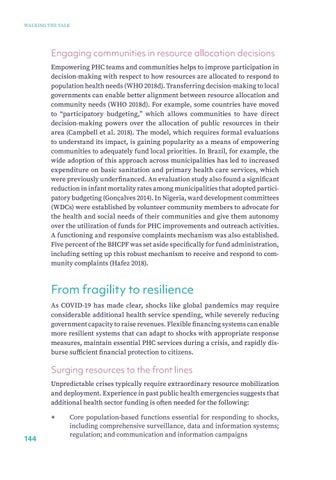WALKING THE TALK
Engaging communities in resource allocation decisions Empowering PHC teams and communities helps to improve participation in decision-making with respect to how resources are allocated to respond to population health needs (WHO 2018d). Transferring decision-making to local governments can enable better alignment between resource allocation and community needs (WHO 2018d). For example, some countries have moved to “participatory budgeting,” which allows communities to have direct decision-making powers over the allocation of public resources in their area (Campbell et al. 2018). The model, which requires formal evaluations to understand its impact, is gaining popularity as a means of empowering communities to adequately fund local priorities. In Brazil, for example, the wide adoption of this approach across municipalities has led to increased expenditure on basic sanitation and primary health care services, which were previously underfinanced. An evaluation study also found a significant reduction in infant mortality rates among municipalities that adopted participatory budgeting (Gonçalves 2014). In Nigeria, ward development committees (WDCs) were established by volunteer community members to advocate for the health and social needs of their communities and give them autonomy over the utilization of funds for PHC improvements and outreach activities. A functioning and responsive complaints mechanism was also established. Five percent of the BHCPF was set aside specifically for fund administration, including setting up this robust mechanism to receive and respond to community complaints (Hafez 2018).
From fragility to resilience As COVID-19 has made clear, shocks like global pandemics may require considerable additional health service spending, while severely reducing government capacity to raise revenues. Flexible financing systems can enable more resilient systems that can adapt to shocks with appropriate response measures, maintain essential PHC services during a crisis, and rapidly disburse sufficient financial protection to citizens.
Surging resources to the front lines Unpredictable crises typically require extraordinary resource mobilization and deployment. Experience in past public health emergencies suggests that additional health sector funding is often needed for the following: ++ 144
Core population-based functions essential for responding to shocks, including comprehensive surveillance, data and information systems; regulation; and communication and information campaigns
